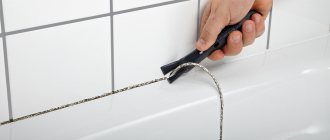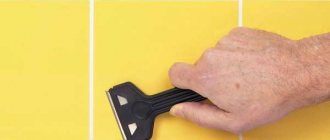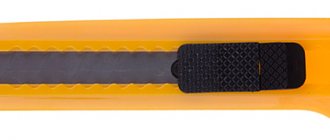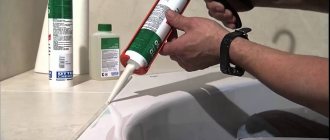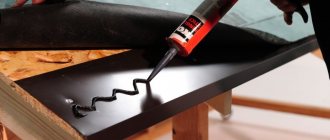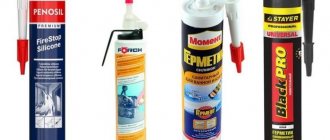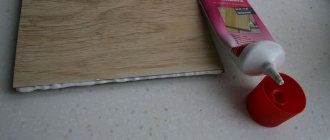Removing silicone sealant from a bathtub without damaging it is not so easy, because the material has good adhesion to various surfaces and is quite difficult to remove.
Silicone sealant can be one-component or two-component. Its main property is due to its resistance to various aggressive environmental influences. Silicone is widely used in construction not only indoors, but also outdoors.
Possible cleaning methods
In order not to worry about how to wash silicone sealant, it is recommended to remove excess material before it dries. The “fresh” (not hardened) mixture can be easily washed off with a regular sponge. The use of rags is allowed.
Once the silicone hardens, it is quite difficult to remove. This is especially true for embossed materials (various types of tiles). If the technology has not been violated, silicone sealant adheres to them very strongly.
If you plan to reapply the mixture to the surface, it is important to pay a lot of attention to removing the existing layer. This necessity is explained by the lack of adhesion between silicone molecules, which have already undergone polymerization and have just begun this process.
It is also important to thoroughly clean the surface of any silicone that has gone beyond the permissible limits during application. Even transparent material becomes dirty and dark during use, which disrupts the appearance of finishes, plumbing fixtures and other products.
Silicone affected by mold Source ytimg.com
Mechanical methods
Before removing silicone sealant, the surface should be mechanically treated. They are trying to get rid of as much material as possible. Mechanical cleaning is carried out using any devices. It is desirable that they be sharp and thin. The most suitable tools are:
- Metal spatula . It copes well with removing contaminants on non-relief surfaces formed from different materials. An important requirement is that the working edge of the spatula must be smooth. Otherwise, the surface being treated may be scratched.
Metal spatula Source dobrostroy.rf
- Razor blade . Must be used extremely carefully. If used carelessly, there is a risk of injury and leaving scratches on the surface being treated.
- Knife . It is better to use a special wallpaper. Using a knife is convenient for removing large accumulations of hardened mixture.
Wallpaper knife Source prom.st
- Bank card . It is formed from soft plastic, so it is not capable of scratching or damaging the surface. But the card will not cope with serious contamination. It is recommended to use it after using one of the chemicals.
After preliminary rough treatment, it is recommended to continue cleaning using any abrasive. Pumice stone, hard sponge or salt will do. You need to rub it carefully to avoid scratches. For glass or ceramics, it is better to use fine salt.
Salt is suitable for cleaning Source yandex.net
See also: Catalog of companies that specialize in paints, protective and finishing materials
Chemical methods
To determine how to clean silicone sealant, you need to know its exact composition. Conventional construction silicone most often has an acid base. This is evidenced by the cloying smell of vinegar. It appears immediately after applying the mixture and remains until it hardens. To clean surfaces from this type of silicone, use concentrated acetic acid 70%.
In addition to acidic, sealants can also have another neutral base:
- Oxide . Can be removed using any solvent or purified gasoline.
- Alcohol . For cleaning, it is recommended to use ethanol (technical, food grade).
- Amide . It is removed in the same way as the oxide mixture.
A variety of chemicals Source avtoelektrik-info.ru
Before choosing how to remove silicone sealant, you need to understand that some materials can only be processed mechanically. This applies to polyurethane mixtures. Once polymerization is complete, this material can only be removed with a very sharp, thin blade. If the polyurethane mixture has not yet completely hardened, try to partially wash it off with a solvent.
When using any silicone sealant remover, you must consider the type of surface being treated. Contact of varnished or painted material with solvents is prohibited. There is also no need to clean glass with gasoline. This will lead to the formation of divorces. It is impossible to get rid of them in the future.
Industrial products
The most popular cleaners:
- H.G. _ The product is suitable for removing stubborn stains. It has a pleasant smell and does not spoil the appearance of the products.
Industrial cleaner Source ozone.ru
- Tytan . Contains acids. The product shows good results on surfaces with depressions. The advantage is the absence of a pungent odor.
- XADO Mottec . The product is made on an alcohol basis. Great for acrylic. After drying, it leaves no traces.
- Soudal . Differs in hydrocarbon base. It is recommended to apply only after complete removal of moisture. It is advisable to test the product before use, as it can leave greasy marks.
How to remove fresh sealant
Professional finishers know secrets that make renovation work easier. They apply strips of masking tape along the joint to be insulated. Excess silicone remains on them and is easily removed. Beginners simply squeeze the composition out of the tube, which leads to contamination.
While the silicone has not hardened, you can get rid of it using a sponge or napkin moistened with soapy water. It is enough to wipe the surface thoroughly. If the composition has been on the tiles or bathtub for more than 20 minutes, you will need to soften it with vinegar . Then wipe the stain with a dry cloth . Also remove excess with a damp rubber spatula .
Methods for cleaning different surfaces
To determine how to remove silicone sealant, you need to try and combine different methods. Specific recommendations depend on the type of coating being treated.
Removing unusable sealant Source prorab.help
Bath
When choosing how to clean the sealant on the bathtub, you can follow the following tips:
- The layer of hardened mixture must be carefully pryed off with a sharp blade.
- Use your hands to try to completely remove the material.
- The surface should be wiped with a damp cloth soaked in salt of minimal grain size.
- If there are traces of the sealing agent left on the bathtub, they can be washed off with vinegar or solvent.
If the silicone-containing substance has not yet hardened, there is no need to perform these manipulations. The mixture that has contaminated the surface of the bath can be easily removed with a solvent.
Removing silicone-containing products from the bathtub Source kak-otteret.ru
Tiles on the wall
To understand how to wash silicone, you need to read the following instructions:
- It is recommended to remove large pieces of silicone using a thin object.
- A washcloth is soaked in a solvent and the dirty tiles are treated. There must be a lot of liquid so that it can be “absorbed” into the hardened mixture.
- After 10 minutes, remaining silicone can be removed with a hard cloth soaked in solvent.
- At the final stage, it is recommended to wash the tiles using a soap solution.
Chemical methods
The industry produces special chemicals for removing sealant from various surfaces. They are selected taking into account the material of the bathtub and the chemical resistance of the tiles. Chemicals will help remove the sealant from the bathtub quickly, but they must be used with caution.
Old silicone applied in a thick layer can be removed using white spirit. The solvent will soften the silicone composition. The sealant will be easier to remove and wipe off the bathtub. Using white alcohol takes some time as the liquid needs to be absorbed and the chemical reaction begins. The cleaning process takes 3-4 hours.
To clean the bath, it is allowed to use reagents containing methylsiloxane components. Such solvents quickly soften the connections between the surface and the sealants. With their help they achieve good results.
All chemicals are aggressive and can harm human health, so it is important to adhere to safety measures when working with them.
Precautionary measures
When using chemical solvents and other special compounds for cleaning, it is important to ensure safe working conditions when working with the substance. The following must be taken into account:
- the room should be well ventilated;
- It is allowed to work only with rubber gloves and a protective mask;
- the use of chemicals near fire and smoking during work are prohibited;
- you must strictly adhere to the manufacturer’s recommendations for handling the product;
- Upon completion of work, you must wash your hands thoroughly with soap.
It is also important to be careful when working with sharp piercing and cutting objects. After all, in order to clean the product from sealant, you often have to use blades or knives. They are necessary to remove the top layer of silicone.
Briefly about the main thing
It is quite difficult to remove hardened sealant from any surface. Therefore, it is recommended to remove traces of the mixture before completing its polymerization.
Mechanical techniques and various chemicals are used to remove silicone-containing compounds. It is recommended to initially clean the surface with a wallpaper knife or spatula. After removing large pieces of material, you can move on to final cleaning using ethanol, solvents and other substances.
There are industrial products on sale that effectively deal with stains from silicone rubbers. They are used exactly according to the instructions after preliminary testing.
Ratings 0
Advice from professionals
Experts recommend:
- Before using a chemical, you need to apply it to a small and inconspicuous area of the bath and monitor the reaction of the material to the chemical. This way you can avoid damage to the product.
- When working with sealant, it is advisable to wipe off drips and drips before it hardens.
- Silicone substances have a destructive effect on products made of polyacrylate and polycarbonate. In this regard, it is not prohibited to combine them.
- You should always follow the rules for working with chemicals.
With a competent approach to the procedure, removing the sealant from the bathtub will not be difficult.
Features of cleaning bathtubs from silicone
To avoid damaging the bathtub coating, you need to choose a cleaning method suitable for acrylic, cast iron or enamel.
Acrylic
Acrylic requires delicate, regular care. A simple way to avoid damaging the product is to test on a small area whether the cleaning agent is suitable or not. Apply the cleaner for half an hour. If roughness and other defects do not appear, the product is suitable.
Mechanical and chemical cleaning methods are suitable for acrylic Jacuzzis. Use a knife, pumice stone, or blade to remove the top layer of material, then scrub with a rough washcloth or soft brush.
Liquids that are highly effective are SanClean, PaniVanna, Triton, White Spirit.
Cast iron
Steel and cast iron can be cleaned by any means. The upper layers of sealant are removed mechanically, and the lower ones - with chemical, household cleaners.
At the end of the procedure, yellow marks remain. They are easily washed with powder, dishwashing detergent, liquid and laundry soap. Acetic, citric, carboxylic acid, and baking soda remove stains forever. Pour the granules onto a cloth, moisten it with water and rub the surface until the marks disappear.
Products made of cast iron are not afraid of damage. During processing they are exposed to high temperatures, ensuring their durability. Popular cleaning products are ideal for combating silicone.
Enameled
The enamel must not be cleaned with powders or metal brushes. They damage the coating, leaving huge scratches and dirty streaks. Cleaning products in the form of pastes and creams (Penta, Mellerud, Silicon-Entferner) will help you get rid of sealant.
Some general information
This composition is a very thick, pasty mixture characterized by sluggish flow. Upon contact with air, it polymerizes, that is, it hardens or becomes densely elastic. A compound is used to seal and treat joints and joints between different materials to prevent leakage or leakage of liquid.
Depending on the composition, sealants are divided into several types:
- silicone - the most common;
- acrylic;
- polyurethane;
- silicate;
- bitumen;
- sanitary.
Sealant is a universal and very convenient composition that is actively used in repairs and decoration
. Due to its significant waterproofing properties, sealant is also actively used in renovations in bathrooms, kitchens, and bathrooms. It is used to process joints between the wall and the bathtub, sink and tiles, tile seams and joints between individual plumbing elements.
On a note! When renovating an apartment, silicone options are most often used. They can withstand temperature changes well, are not afraid of water, and their seams are elastic.
The sealant seam retains its properties for a long time. It does not crack, remains elastic and acts as an excellent barrier to water and moisture. But over time, it darkens, colonies of microorganisms may appear on it, and mold or mildew may form, which is especially important for rooms with high humidity. And even the best composition will still gradually perform its task worse and worse. That is why, even if you are not renovating your apartment, you need to monitor the condition of the sealed seams.
Old sealant that needs replacing
So, the main cases when old sealant needs to be removed:
- A previously inaccurately applied layer of sealant;
- wear of the sealing compound;
- mold or mildew on the surface of the sealant;
- cracking of the sealed layer.
